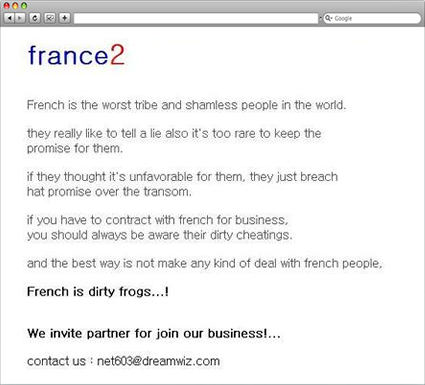Published on 19 April 2013 (Updated 29 February 2024)
Cybersquatting is registering a domain name designating a brand or company to damage or profit from it. Simply put, it’s domain name squatting.
This practice is becoming increasingly common, with the number of cybersquatting complaints in 2016 reaching over 3,000 worldwide.
What’s the risk for your site and your company?
As you will have understood, your competitors or simple cybersquatters can acquire your domain name (your name, your company’s name) on other extensions (.com, .fr, .net, etc.). For example, you may own Mysociety.en, and your competitor – to harm you – freely buys mysociety.com.
Why is this a significant risk?
- Interference with search engine optimization and positioning
A cybersquatter may position his site before yours on Google (even if it’s your company’s name). - Loss of customers: Customers who don’t know the exact address of your website may type in your name with the wrong extension, unknowingly landing on a competitor’s site or an error page, for example.
- Phishing: A cybersquatter can reproduce your website down to the pixel. Internet users may think they’re surfing freely on your site, but in fact, they’re being tricked by pirates, who can retrieve their confidential information (notably customer login details).
- Negative impact on your company’s image: Cybersquatting is not necessarily malicious in the sense of unfair competition. It can, however, hurt a brand’s image when occupied domain names are used for humorous purposes or to make a mockery of your company (see the France2 and France3 examples explained below).
Cybersquatters may then try to sell you these domain names at exorbitant prices. See below for an example of cybersquatting and domain name resale.
Beware of typosquatting! This technique consists of reserving domain names relating to a brand but with typos. Just imagine how many Internet users mistakenly type gooogle.com (with three “o “s) every day…
How can you protect your brand and your company?
In addition to registering your brand with the INPI (Institut National de la Propriété Industrielle), most brand protection on the Internet involves domain names.
Reserve a maximum number of extensions for your brand/company:
The risks in reserving a domain name are negligible for a company because of its price. Today, extensions can be reserved for less than €10/year.
So it’s vital – and we can’t stress this enough – to reserve as many extensions as possible, depending on your target market. If your business is mainly focused on France, a few classic extensions will suffice: fr/eu/com/net.
>> Start by researching a multi-extension search service for your name, company name, etc., and then reserve all the extensions for the domain names you deem useful.
Keep an eye on unavailable domain names:
If certain extensions linked to your company name are already reserved (by competitors or namesakes with different activities), it’s important to keep an eye on these domain names so you can reserve them as soon as they’re available.
Contact our web agency Peexeo if you’d like advice on cybersquatting or to entrust us with the reservation and monitoring of your domain names.
Legal remedies/protection against cybersquatting
As we’ve just seen, the first course of action in the event of cybersquatting is to monitor the domain name. However, some extensions (TLDs) now offer legal recourse and trademark protection.
1 – Generic top-level domains: .com, .net, .org, .biz, .info, .name
Set up by ICANN (Internet Corporation for Assigned Names and Numbers) to combat typosquatting, the UDRP online extrajudicial procedure enables anyone to report a dispute.
Beware, however, that it costs between $1,500 and $5,000 and must be approved by several experts (you’ll see from the list of previous disputes that many cases are in favor of the registrant).
2 – Local domains: .fr, .be, .es…
In France, cybersquatting is not subject to criminal sanctions. Civil actions may be taken before the tribunal de grande instance or the tribunal de commerce in case of a dispute between merchants.
The .fr extension managed by AFNIC is protected by trademark law. In the event of cybersquatting, you can initiate a PARL procedure to declare a legal dispute if it concerns your name or that of your trademark (registered with INPI).
As a general rule, all so-called “local” extensions offer procedures for protecting domain names linked to trademarks in their countries. This is particularly true of Belgium (.be) and its ADR procedure. On the other hand, for many TLDs, such as France or Canada, it is essential to own a company (or the nationality) to reserve the associated domain names (.fr and .ca).
Beware of the services you use to consult the WHOIS of a domain name (directory of domain owners). In our experience, we have extreme suspicions that certain online services cybersquat certain domains following extensive WHOIS searches. Example: you check if mycompany.com is free, then mycompany.fr and mycompany.net, and a robot reserves and cybersquats mycompany.com 15 days later. Use OVH.com (or even better, on the command line).
The example of France2.com and France3.com
When it comes to cybersquatting, the most striking example is the squatting of the France2.com and France3.com domain names. For several years, France Télévisions made unsuccessful attempts to buy these domains. Initially reserved by Russians, these domain names were quickly bought up by South Koreans and their content transformed into pornography or French-bashing insults. Eventually, France2.com and France3.com were recovered by France Télévisions. But at what price?

A business thanks to domain names
- Buying and selling domain names is a lucrative business. Thousands of domains are sold daily on marketplaces like SEDO. In 2011, on the same service, we saw Gambling.com sell for $2,500,000, Dudu.com for $1,000,000, Tada.fr for €20,000 and Megavideo.fr for €16,000.
- Earlier, we talked about typosquatting, the technique of reserving domain names with spelling or typing errors. Many Internet users use this technique to capture traffic from certain sites and redirect it to pornographic or advertising content.





